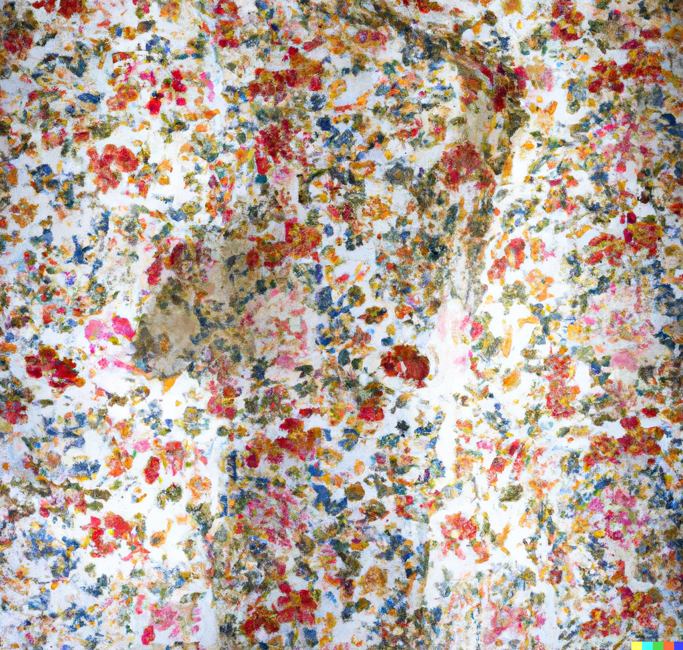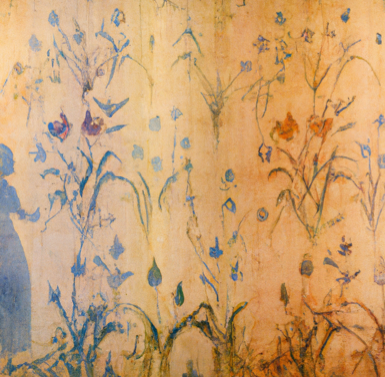Systems Madness is a collaborative NFT project by Claudia Hart and coded by Andrew Blanton, created for the Artblocks platform. It explores the conflict between logo-centric thinking and the improvisatory nature of creative thinking. Inspired by the short story The Yellow Wallpaper (1892) by Charlotte Perkins Gilman, the project uses AI tools to transform literary language into a library of visual tropes, a translation of emotional expression into code. Together the artists reconstructed the pattern language of romantic-era wallpapers, using warm, off-primary colors, noises, gradients, and blurs in many layers, applying different fractal formations that were repeated in irregular intervals to express the human desire to create order out of chaos. Each wallpaper was based on one of five poisonous flowers, to create the infinite variety of Systems Madness interactive patterns. The poisonous and hallucinatory flowers that the artists ultimately encoded were Chrysanthemum, Foxglove, Hydrangea, Poet’s Narcissus, and Poppy. In Gilman’s story, the narrator is the author of short fiction. Her husband, a rational man and a very scientific medical doctor, feels that his wife is too agitated, so he enforces upon her a treatment contrived for unusual women in the age of Freud: complete rest, no guests, no visitors. She takes her rest in a room hung with yellow wallpaper, staring alone at the walls for three months. By the end of this cure, she has completely lost her mind, hallucinating a mad woman imprisoned behind the yellow patterns.

Each unique wallpaper used one of five poisonous flowers, in the infinite variety ofSystems Madness interactive patterns. Pictured below are black Chrysanthemum, brown Hydrangea, and orange Foxglove
Dall-e AI-created wallpapers, used to develop the pattern language that is the basis of the mathematical code used to produce Systems Madness.






Systems Madness “Brown Hydrangea” interactive wallpaper installed at Lume, NYC.
Our work is inspired by a short story by Charlotte Perkins Gilman written in 1892, The Yellow Wallpaper. The narrator of her story is another imaginative woman, a writer of short fiction. Her husband is John, a rational man, and a very scientific medical doctor. John feels that his wife is too agitated, so he enforces upon her a treatment contrived for unusual women in the age of Freud: complete rest, no guests, no visitors. Retired to the country by her doting husband, our narrator takes her rest in a room hung with yellow wallpaper, staring alone at the walls for three months. By the end of this cure, she has completely lost her mind, hallucinating a mad woman imprisoned behind the yellow patterns. My interpretation of the Gilman story is called Systems Madness, a coded system translating her yellow wallpaper into P5js. To accomplish this I invited Andrew Blanton, a composer and accomplished programmer to collaborate.
To decode the semantics of crazy wallpaper, I decided to use Dall-e, the open access AI that creates images from text. Since I was working from literature, I could harness Dall-e to translate literary language into a library of visual tropes. The Dall-edatabase consists of reproductions of canonical images culled from the history of mainstream art history, in other words, of western painting, photography and design. Dall-e, in the end, is a cultural archive, simulating cultural values, cliches and assumptions. It is at its core, a semiotics engine. Dall-e is therefore the perfect tool for deconstructing crazy wallpaper. I realized that Dall-e, because it sits on a specific cultural database, hooks into its unconscious, providing the road to travel in pursuit of the Yellow Wallpaper algorithm - the mathematics behind a story that is a literary icon of both Romantic and feminist fiction.
I typed descriptors into Dall-e, borrowing language from the short story, also intermixed with other related literary, cultural and art references from the same period: “Hallucinatory old floral wallpaper like a watercolor Rorschach test created by Victor Hugo after writing The Hunchback of Notre Dame, then seeing an exhibition of paintings by Odilon Redon,” for example. And also: “Tiny flowers in patterned wallpaper, water-colored, faded and painted by a paranoid schizophrenic woman seeing visions of dancing macabre figures.” I tried many versions, then at a certain point the Dall-e wallpaper designs started repeating themselves. Once they did, I knew I had cracked the code. It was time for Andrew to step in.
To script, Andrew countered my Dall-e semiotics engine with a parallel archive, an MIT open-source processing library and one of the only ones for P5js. Andrew and I then formally deconstructed the pattern language of Dall-e Romantic wallpapers with as much precision as we could muster. “Crazy” patterns consist of colors sampled from my Dall-e wallpaper archives, noises, gradients, transparencies, blurs, in many layers, applying different fractal formations that were repeated in irregular intervals to express the human desire to create order out of chaos.
Andrew then used his library to translate the Dall-e wallpaper language into code. He produced a shader based on the MIT library, scripting five poisonous flowers to create a coded wallpaper system reconstructing madness through its responsiveness to gentle human touch - the slight wiggle of a handheld mouse resetting a pattern into a different time and place. An irrational “reset” button! Produced by rational mathematics, our Systems Madness suggests insane hallucinations. Together, Andrew and I framed a question - what happens when reason meets unreason? The response: the all too human desire to create order out of the chaos of this world; and identically - the truth - that too much order can drive you mad!
-Claudia Hart
January, 2023